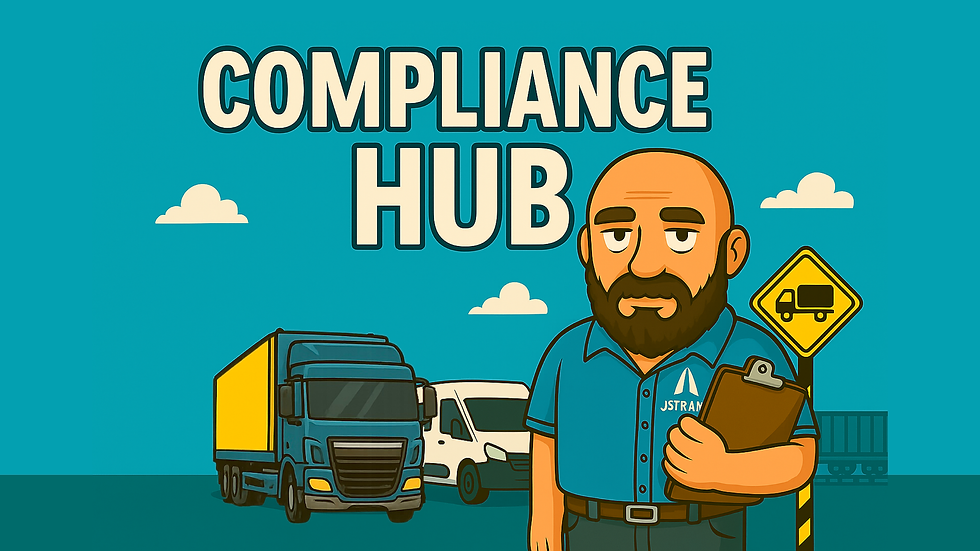Keeping Digital Maintenance Records: Benefits & Best Practices
- stuart47304
- Jul 8, 2025
- 4 min read

If you’re still keeping your maintenance records in a lever-arch file or scribbling on service sheets in the cab, you’re not alone. But switching to digital record-keeping can make a huge difference — especially for Restricted Operator Licence holders who want to stay compliant without drowning in paperwork.
In this guide, we’ll cover:
Why digital maintenance records are a smart move
What records you need to keep (and for how long)
The key benefits of going digital
Best practices for small fleet operators
Tools and systems you can use
How to stay DVSA-compliant with minimal admin
What Are Maintenance Records — and Why Do They Matter?
Maintenance records are written proof that your vehicles are being:
Regularly inspected (PMIs)
Serviced and repaired correctly
Kept in roadworthy condition
The DVSA and Traffic Commissioner expect you to keep accurate records for at least 15 months. These are often requested during:
Roadside checks
DVSA desk-based assessments
Public Inquiries
Operator licence applications or variations
Without records, you can’t prove your compliance — and you could face prohibitions or even lose your licence.
What Maintenance Records Should You Keep?
Here’s a breakdown of the key records you need to store digitally or on paper:
Record Type | Required Details | Retention |
PMI reports | Date, vehicle ID, checks done, defects found, repairs, sign-off | 15+ months |
Service invoices | Parts, work done, date, vehicle, mileage | 15+ months |
Defect reports | Daily walkaround sheets, issues found, driver name, date | 15+ months |
Repair records | Who did the work, what was done, when, invoice/job card | 15+ months |
Brake test reports | Printout or report, test date, results, vehicle ID | 15+ months |
Tachograph calibrations | Date, certificate or printout | Until next calibration |
Why Go Digital?
While paper records are legally acceptable, digital systems offer huge advantages for modern operators:
✅ 1. Faster Access and Easier Storage
Find any report in seconds with keyword or date search
No lost paperwork or water-damaged folders
Access from your phone, laptop, or cloud storage — even on site
✅ 2. Improved Organisation
Automatically sort records by vehicle or date
Colour-coded folders for PMIs, services, and defects
Easy sharing with DVSA or consultants
✅ 3. Less Admin and Fewer Errors
No duplicate entries
Standardised templates reduce missed info
Reminders and auto-notifications help you stay on track
✅ 4. Stronger Audit Trail
Digital timestamps and history logs
Proof of when defects were reported and repaired
Clear evidence for DVSA inspections or Public Inquiries
✅ 5. Better for Remote or Mobile Operators
If you work from home, on-site, or on the move, digital records go with you
You don’t need a filing cabinet in the passenger seat
Best Practices for Digital Record-Keeping
✅ 1. Create a Digital Folder Structure
For example:
scssCopy
📁 Maintenance Records ├── Vehicle 01 (AB12 XYZ) │ ├── PMIs │ ├── Repairs │ ├── Daily Checks │ └── MOTs ├── Vehicle 02 (CD34 ABC) │ └── (same folders) └── Templates and Schedules
✅ 2. Use Consistent File Naming
Examples:
PMI_HGV01_2025-07-01.pdf
BrakeTest_HGV01_2025-06-10.pdf
DefectReport_VAN02_2025-07-04_JSmith.pdf
This makes searching and filing much easier.
✅ 3. Set Regular Reminders for Uploading
After each PMI, scan and upload immediately
Keep a list of expected records each month
Use Google Calendar or Trello to track what’s due
✅ 4. Use Scanning Apps or Cloud Tools
Useful apps and tools:
Tool | Purpose |
Microsoft Lens | Scan paper reports via phone |
Google Drive / Dropbox | Cloud storage and sharing |
Trello / Asana | Task reminders |
Sheets / Excel | Maintenance planner |
CheckedSafe / R2C / Truckfile | All-in-one compliance apps (optional) |
✅ 5. Back Up Everything
Use cloud storage and local backup (e.g. USB drive or external hard drive)
Protect against accidental deletion or system failures
DVSA won’t accept “the laptop crashed” as an excuse
Digital vs Paper: Quick Comparison
Feature | Digital | Paper |
Storage space | Minimal | Bulky |
Searchability | Instant | Manual |
Sharing | Easy (email or link) | Scanning required |
Risk of loss | Low (with backups) | High (fire, damage, misplacement) |
Legal validity | ✅ | ✅ |
Both are acceptable — but digital is more efficient and easier to manage over time.
How DVSA Views Digital Records
DVSA is fully supportive of digital systems, provided:
Records are complete and legible
They are organised and accessible on request
Defect rectification is clearly shown
Files are kept for the required period (15 months minimum)
During audits, operators who present digital records professionally are often viewed more favourably.
Common Mistakes to Avoid
Mistake | Problem |
❌ Uploading scanned images with no naming system | Makes searching a nightmare |
❌ Only keeping records in email inboxes | Easy to lose or overlook |
❌ Not backing up cloud storage | Risk of data loss |
❌ Forgetting to upload reports after PMI | Missing audit trail |
❌ Relying on garage to keep your records | You must keep your own copies! |
Top Tip: Combine Digital Records with a Maintenance Planner
Use a digital spreadsheet or planner to:
List all upcoming inspections, MOTs, and brake tests
Tick off completed tasks with links to saved records
Highlight overdue items
✅ This creates a powerful visual snapshot of your compliance.
Conclusion
Going digital with your maintenance records doesn’t mean investing in expensive systems or hiring IT consultants. With just a smartphone, a cloud account, and a few simple habits, you can create a streamlined, audit-ready record-keeping system that saves time and protects your licence.
As a Restricted Licence holder, you wear many hats — so give yourself every advantage by making compliance easy, portable, and paperless.
Next in the series:👉 What Is an Operating Centre? A Plain English Guide for Small Fleet Owners
